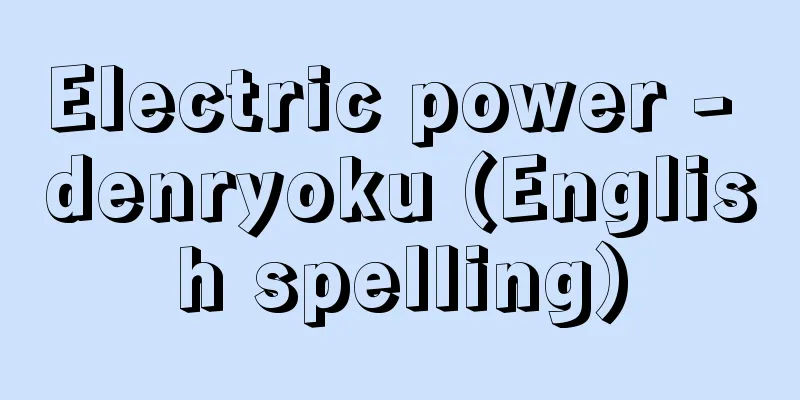Electric power - denryoku (English spelling)

|
This refers to the electrical work done in one second. In general, the work done in one second is called power, whereas in electrical engineering, the term power is used. When a voltage is applied across a resistor in a DC circuit, a current flows through the resistor. This is a phenomenon in which charged particles (mostly electrons) are moved by the force of an electric field, consuming energy. This energy is supplied from a power source and is converted into heat. In this case, the power is equal to the product of the square of the current and the resistance. This is equal to the product of the voltage across the resistor and the current flowing through the resistor. In an AC circuit, both the voltage and current are changing, so the average of one cycle is called power, and if effective values are used for the voltage and current, the relationship in the case of DC holds true as is. However, when a circuit contains a resistance component (mainly due to resistors) and a reactance component (mainly due to coils and capacitors), only the resistance component consumes energy, and the reactance component does not consume energy, so the product of the voltage across the circuit and the current flowing through the circuit does not represent power. This is the apparent power, and is called apparent power. When it is necessary to distinguish power from apparent power, it is called active power. In contrast, when the load is only a pure reactance component, the power that goes back and forth between the power source and the load and is not consumed is called reactive power. Complex power is expressed as a complex number (a number expressed in real and imaginary units) with active power as the real part and reactive power as the imaginary part, and apparent power is obtained by adding the squares of the real part and the imaginary part and taking the square root. With electrical energy, the power is electric power not only when it is converted into heat, but also when it is converted into mechanical energy, such as in a motor. Furthermore, even when there is no voltage between terminals or current flowing through a conductor, such as with electromagnetic waves, power still exists. In this case, the vector product of the electric field and the magnetic field represents the flow of power per unit area. This is called the Poynting vector. The power rate of 1 joule per second is defined as 1 watt. [Madashi Fuse and Masazumi Yoshizawa] [Reference] |Source: Shogakukan Encyclopedia Nipponica About Encyclopedia Nipponica Information | Legend |
|
1秒間に行う電気的仕事をいう。一般に1秒間に行う仕事を仕事率というのに対し、電気工学では電力という術語を使っている。直流回路の抵抗の両端に電圧を加えると、抵抗中を電流が流れる。これは電界によって荷電粒子(多くの場合電子)が力を受けて動く現象で、エネルギーを消費する。このエネルギーは電源から供給されたものであり熱に変わる。この場合の仕事率すなわち電力は、電流の2乗と抵抗の積に等しい。これは抵抗の両端の電圧と抵抗を流れる電流の積に等しい。交流回路の場合は電圧、電流ともに変化しているので、1周期の平均を電力といい、電圧、電流に実効値を用いれば、直流の場合の関係がそのまま成り立つ。しかし、回路に抵抗成分(おもに抵抗器による)とリアクタンス成分(おもにコイルやコンデンサーによる)を含む場合は、エネルギーを消費するのは抵抗成分だけであり、リアクタンス成分はエネルギーを消費しないので、回路の両端の電圧と、回路に流れる電流の積は電力を表さない。これは見かけの電力であり皮相電力とよんでいる。電力を皮相電力と区別する必要があるときは有効電力という。これに対して、純粋なリアクタンス成分のみが負荷の場合、電源と負荷の間を行ったり来たりして消費されない電力を無効電力とよぶ。有効電力を実数部とし無効電力を虚数部として複素数(実数と虚数単位で表される数)表示したものを複素電力といい、実数部の2乗と虚数部の2乗を加えて平方根をとったものが皮相電力である。電気的エネルギーでは、それが熱に変換される場合に限らず、たとえばモーターのように機械的エネルギーに変換される場合でも、その仕事率は電力である。 さらに電磁波のように、端子間の電圧や、導線を流れる電流も存在しない場合でも、電力は存在する。この場合は、電界と磁界のベクトル積が単位面積当りの電力の流れを表す。これはポインティング・ベクトルとよばれている。毎秒1ジュールの仕事率を1ワットと定めてある。 [布施 正・吉澤昌純] [参照項目] |出典 小学館 日本大百科全書(ニッポニカ)日本大百科全書(ニッポニカ)について 情報 | 凡例 |
Recommend
Overrunning Zone - Overrunning Zone
…Of these, the parallel runway arrangement of = a...
Shigenari Inage - Inage Shigenari
Year of death: 23rd June 1205 (11th July 1205) Yea...
Perch sculpin
A marine fish belonging to the order Perciformes ...
Standardization - hyojunka (English spelling) standardization
In psychological tests such as intelligence tests ...
Single
…After the Renaissance, in Belgium, the Netherlan...
Eṭṭutokai (English spelling)
… [Masayuki Onishi] [Tamil Literature] The Dravid...
Asogo - Let's play
…The Yoshioka Copper Mine is known as one of the ...
Liber legendarius (English spelling)
...general term for books that record the biograp...
Anzeilen
〘Noun〙 (anseilen) When climbers ascend in dangerou...
Shirakawa [village] - Shirakawa
A village in Ono District, on the northwestern edg...
Irihama
〘 noun 〙 A salt field where a dike is built on a s...
birdie
…An 18-hole course is usually designed with 4 sho...
Sicista betulina (English spelling)
…[Yoshinori Imaizumi]. … *Some of the terminology...
Mochizuki [town] - Mochizuki
A former town in Kitasaku District, eastern Nagano...
part-time job
〘 noun 〙 (Arbeit) ① labor. work. job. [The Fountai...









